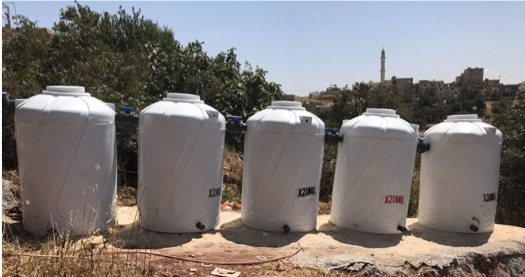WHAT IF... you eliminated technological and service dependencies from international suppliers and competitors through local and tailored value creation?
The value creation and production of many products and services requires physical resources. When developing business models, entrepreneurs will be quickly confronted with the question how and where to source inputs for their production. In a globalised world, one would immediately consider sourcing where availability and quality of inputs is high, prices are competitive, and delivery is reliable. Applying these criteria could often mean sourcing inputs from various, possibly distant, locations worldwide. Yet, it can be a smart innovation strategy to opt for local sourcing. The reasons for this include stronger supply chain control, increased flexibility due to simplified logistics, reduced supply chain costs, currency risks and environmental footprint of transport, predictable maintenance efforts, a local marketing strategy and brand image, etc. Moreover, local sourcing is a driver for local economic develop and generates societal benefits.
Turning challenges into opportunities
Every water, sanitation or waste start-up offering a product or a product component along with service solutions requires supplies, materials or goods. Those physical resources could range from raw materials, such as chemicals, fabrics and polymer membranes for water treatment to advanced machinery for waste recycling or vehicles for transportation.
When building a supply chain for these key resources, you have the choice between different strategies to pursue, among them a local or global supply chain strategy. Many companies run a mixed strategy, meaning they source part of their goods locally and others globally (KfW – DEG 2018).
For young businesses entering the market, it is indeed relevant to look for suppliers who can deliver the best product for the best price. However, limited experience and international networks, lack of specialised knowledge in import logistics, limited financial resources and relatively small scales of production can be reasons to identify ways to reduce the vulnerabilities, risks and logistics costs associated with long supply chains (WYMAN 2014).
Instead of investing significant resources into developing international supply chains, pursuing a local sourcing strategy can yield various benefits for your business.
Moving towards a strategy
Sourcing locally means to work with suppliers, manufacturers and people from your region or target market.
Localisation can often be an effective tool to compete against standardised solutions and makes your offers more difficult to copy for international competitors. In the long run, less standardisation might come at a certain cost, but allows changes and more innovation along the supply chain (RYAN, 2018).
Another motivation to buying goods of domestic origin is related to the environmental and social impact objectives of a business and its brand image accordingly. Minimising the environmental footprint through short supply chains and contributing to the development and well-being of local market structures are significant indirect benefits of local supply chains. In particular in developing markets, an increase of the local part of business’ sourcing has a significant effect on the money spent and value created in these markets (KfW – DEG 2018).
Early stage hardware start-ups in particular benefit from partnering with local manufacturing partners who can support prototyping and product development. Although production costs might be high, savings on expedited logistics and travels and the ability to work intimately with the supplier, are important advantages. The start-up is able to maintain flexibility across product and process development (RUPPERT 2017).
There are several aspects that need to be considered when establishing and managing a (local) supply chain.
The first step is to identify what resources, materials and other inputs you need for production or to offer your service. These inputs are essential to create value for the customers as well as to sustain and support the business itself. Although the scale of production might change depending on the enterprise’s growth, it is important to estimate quantity and define characteristics and quality of all key resources.
As a second step, analysing the current and potential local market is crucial to understand capacities of suppliers. In some cases, all the resources you need might be available locally. If not, you can explore if the design of your offer can be adjusted to work with products, materials or services that are locally available. Alternatively, local suppliers might be open to adapting their offers or production to your needs – talk to them! Recognising and unlocking such a potential through supplier development can create strong local business networks (TEAM THOMAS 2019).
In a third step you should assess the obstacles and benefits of local sourcing for your business. Benefits could impact the business model in multiple ways, for instance lower costs and shorter production times due to higher stability and predictability of supplies, better quality control and management of maintenance requirements for the business and the product or service you offer, benefits to environment and community by creating jobs which can serve as a marketing strategy, etc. Yet, sourcing from domestic markets might come with challenges, including potentially less reliable local suppliers (both when it comes to timely delivery and compliance with standards) or high resistance to change supplier offers to your needs. Achieving cost reduction through bulk sourcing and economies of scale is another typical challenge in local sourcing. As an entrepreneur, you need to compare obstacles and expected benefits to decide whether this is a feasible innovation strategy for you (KfW – DEG 2018).
Case Study 1
Solvillion was founded in 2018 and provides much-needed solutions in the field of water and wastewater by offering decentralised wastewater treatment system that allow to recycle wastewater (grey water and blackwater) and reuse it for agriculture. The customised treatment system targets rural households as well as institutions (schools, mosques, etc.), which do not have access to the sewer system, suffer from environmental pollution and face water scarcity. The on-site system offered by Solvillion is easy to maintain, low in energy consumption and saves desludging costs.
Although there is an abundance of treatment technologies and prefabricated systems all around the world, Solvillion has consciously decided to design their treatment system solely based on locally available materials. The main reasons for the businesses localisation at current times include:
- At start-up and growth stage, the treatment system is continuously piloted and improved.
- Local sourcing allows to quickly buy parts in small quantities from different places and validate suppliers and qualities
- The tanks that are used as a core part of the design are of large volume and come with high import costs if shipped from abroad
- The import regulations are strict and difficult for young businesses to navigate in terms of costs, time and knowledge
- Most system materials are cheaper in the local market than abroad

SOLVILLION Treatment System. Source: SOLVILLION

SOLVILLION Team. Source: SOLVILLION

